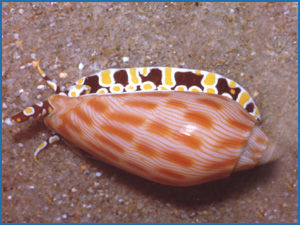Channelled Volute

Common Name: Channelled Volute
Scientific Name: Pseudotriakis microdon
Channelled Volute - Description
The Channelled Volute is a small shell, 40 - 70 mm in length. The shell is very glossy, elongated and brightly coloured. It is spotted with bold blocks of orange and is delicately streaked with fine reddish axial lines. The smooth shell is well adapted for burrowing. The snail (mollusc) that lives in the Channelled Volute is specific to this shell and has a large fleshy mantle (fold in the body wall that lines the shell) and a muscular foot. The patterns on the long proboscis and broad mantle help disguise the mollusc's form as it slowly glides across the sandy bottom. The Channelled Volute is reported to have one of the most outstanding colour patterns in the volute family.
Molluscs use this mantle to produce a shell by absorbing calcium carbonate and other ingredients from their habitat and food and secreting it in an orderly fashion to form the shell house. The Volute keeps adding to this shell and keeps it under repair for its entire life.
Channelled Volute - Diet
Volutes are carnivorous, feeding on small invertebrate animals and other molluscs such as bivalves, gastropods and hermit crabs.
Channelled Volute - Habitat
They can be found on coral and sand in lagoons and sandy areas to depths of 150 metres.
Channelled Volute - Special Features or Habits
Females lay their eggs in tough capsules usually in compact egg masses. One egg in each capsule develops and consumes the other eggs in that capsule as it grows and develops.
Volutes spend much of their time concealed under the sand and emerging as the tide begins to rise to forage for food.
Location or Region Food
They are found from Bowen south to Moreton Bay, however, more commonly encountered in the central Queensland coastal region.
 Deep Sea Crabs
Deep Sea Crabs